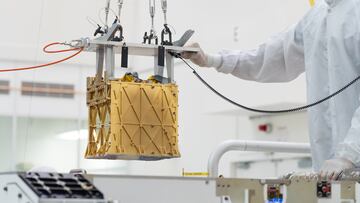NASA makes oxygen from carbon dioxide on Mars
The MOXIE device built into the Perseverance rover has proved capable of creating oxygen on the red planet, a key step in the bid to get humans to Mars.

Researchers from NASA have confirmed that the Perseverance rover has successfully made breathable oxygen on Mars from the planet’s thin atmosphere.
Among the various experiments carried out by the NASA rover is MOXIE, a device the size of a lunch box that for the past year has carried out the same job that trees and plants do on earth: turning carbon dioxide into oxygen.
The experiment, overseen by the Massachusetts Institute of Technology (MIT) and published in Science Advances, will form a central part of the space agency’s long-term mission to get humans to Mars.
So far researchers have released results on seven occasions and in each instance MOXIE achieved its objective of producing six grams of oxygen per hour. This is the same rate at which a small tree could do so on Earth, according to the MIT statement.
NASA hopes that the machine can one day be used on manned missions to prevent astronauts from needing a huge supply of oxygen aboard their craft. This mission is the first demonstration of the technology ‘in situ’ and it has been a complete success.
Since Perseverance landed in Jezero Crater in February 2021, MOXIE has shown that it works in all seasons of the Martian year and in various time bands to extract oxygen from the planet’s CO2-rich atmosphere. Researchers envision that a larger version of MOXIE could be sent to Mars before the first human mission to continuously produce oxygen at the rate of several hundred trees. This could both generate enough oxygen to sustain people and help fuel the rocket on their return to Earth.
How does Moxie work?
The project’s lead, Michael Hecht of MIT, stressed that his team have learned a lot from this experiment, which will serve as the basis for future larger-scale systems. The current version had to be small enough fit aboard Perseverance and is only designed to function for short periods, starting up and shutting down with each drive.
The machine works by pulling air from the Martian atmosphere through a filter which cleans it of contaminants, after which it is pressurized and sent through the solid oxide electrolyser (SOXE). This electrochemically splits the CO2 in the air into oxygen ions and carbon monoxide.
Oxygen ions are isolated and recombined to form breathable molecular oxygen (O2), which MOXIE measures for both quantity and quality before releasing it back into the air, along with the other carbon monoxide and atmospheric gases.
The density of the atmosphere on Mars varies much more than on Earth so researchers have had to conduct a series of test to judge how reliable the technology is. MOXIE worked well during both day and night; at extreme temperatures; and even in the wake of a dust storm.





